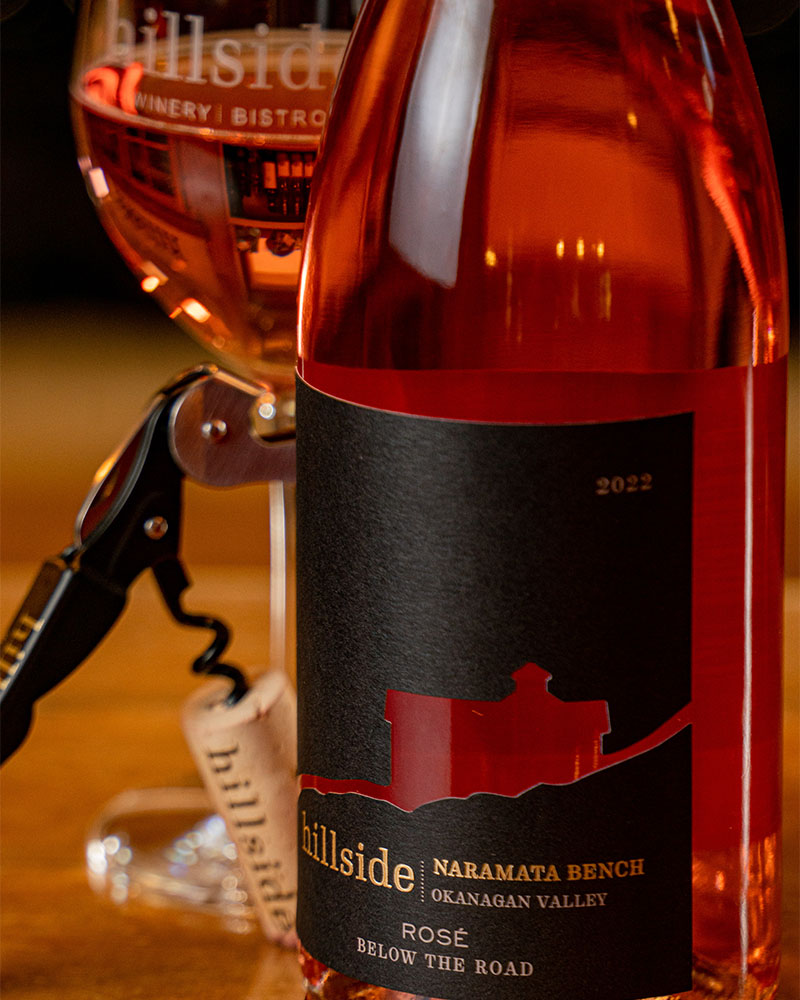August is BC Rosé Month, so let’s talk about rosé! We have made our Hillside Rosé since 2005 with sales being slow for the first few years. In 2008 we had a rockstar salesman in our wineshop who was able to double sales by convincing the male contingent that rosé is a very manly wine: “it’s not pink, it’s salmon-coloured. Salmon is a fighting fish”, and Rosé became one of our all-time fan-favorites.
Initially Hillside Rosé was made only as a saignée. The French term for “bleed”, saignée refers to the practice of draining off a percentage of juice immediately after sorting and de-stemming red grapes (no crushing–we don’t own a crusher) in order to increase the skin to juice ratio in this mother tank. This is done on a vineyard block by vineyard block basis depending on the desired outcome. If a block is expected to be part of Mosaic or another of our “bigger” reds, we will take a drain, or saignée to concentrate the colour and tannin which reside in the skin of the grape. When we have a super warm year, with late season heat and thus dehydration of the grapes, we will not take a drain, as the grapevine has already done the concentrating for us.
The juice that is drained is blended together and fermented as a white wine to become rosé. As conditions change vintage to vintage, so does the blend of varieties, creating an always-interesting wine.
In 2010 after a cool growing season, I realized that one block of Merlot in our Hidden Valley Vineyard would struggle to achieve tannin ripeness. The fruit flavour was lovely but, had we made a red wine, we would have had un-ripe astringent tannin to deal with. We decided to turn the whole block into rosé. The fruit was hand-picked then sorted and de-stemmed directly to the press which separated the juice from any astringent tannin in the skins. The juice was cold settled and transferred to a fermenter and the wine was made according to white winemaking protocol—long cool controlled fermentation–to best capture the aromatics.
Why is this block less-ripe? It is on the southern arc of our bowl-shaped vineyard, facing north, so it gets less focused sun-exposure, especially in the afternoon when the sun’s effect on the vine is greatest. Realizing this impact, I decided to use this block for rosé every year.
Similarly, we contract a block of Cabernet Franc which is in the ideal spot for this grape, but has a small section that is directly behind a row of very tall fir trees, so does not achieve full tannin ripeness. This part of the block is harvested separately and always goes into rosé.
So, in many ways, having rosé in the Hillside portfolio allows us to grade the blocks of red varieties and bring out the best in the wines.
I have always wanted to utilize oak barrels in Rosé winemaking, so in 2022 we experimented with putting a portion of the wine into barrels immediately following fermentation. This gave the wine some lees contact, as the spent yeast slowly disintegrated, contributing creaminess to the mouthfeel. For this experiment, we used only wine sourced from “below the road” the western side of Naramata Bench which, during the last ice age, had been lake bottom, comprised of fine-grained silty loam. The result was our single vineyard series “Below the Road Rosé”. It has both saignée and press juice, along with some viognier to contribute a floral touch.
In 2023 we took it a step further and fermented in barrel, using neutral French oak. The result is a wine of great complexity and, yes, sophistication. It is more of a food wine, inviting interesting pairings, than its patio-sipper cousin, the Hillside Rosé. Which is my favorite? Like my cousins Billy and Bobby, I love them both in different ways.
In the past I have received some constructive criticism on the colour of our Rosé from wine writers as they were accustomed to the white-pale shades of Provençal rosé. I studied on it a bit and learned that, because the pale colour is a bit of a badge of honour for the French, they go to great lengths to achieve it, from picking less ripe-so that colour is not fully developed in the fruit-to carbon fining!
Blessed in the Okanagan with deeply coloured grapes, the juice is quite dark with almost no skin contact when the fruit is ripe. Less ripe merlot tastes like celery juice, so we prefer to pick ripe and embrace the colour. Our rosés range in colour from wild rose pink to, well, sockeye salmon, and always shine with internal light.
